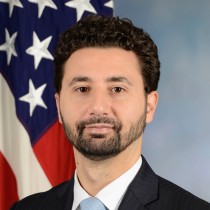

Introduction
The State Department and the Defense Department have just completed mutually complementary reviews of the U.S. Foreign Military Sales (FMS) process. These reviews identify gaps in the system but also propose solutions to retool and streamline the entire enterprise to make it more effective and efficient. In the latest installment of the Defense Rapid Reaction series, experts from MEI’s Defense & Security Program provide their views on what the FMS reforms could or should accomplish and how an improved approach to approving foreign arms sales can strengthen U.S. relations with international partners and allies.
Reactions
-
Bilal Y. Saab
Bilal Y. Saab

Some useful reforms, not enough urgency
You have to give it to both Foggy Bottom and the Pentagon for conducting an all-out blitz to advertise the suggested reforms of the FMS process, which, as all my colleagues here have correctly judged, is broken. That was impressive — and also desperately needed because many U.S. partners are fed up with the FMS system and looking to meet their defense requirements elsewhere. U.S. officials worry about our regional partners going to China and Russia for military equipment. I am actually more concerned about our European competition because the European market has serious capability across domains. Friendly competition is still competition.
I read with great interest every recommendation that came out of the Department of Defense and the Department of State. There is much to like and not much to argue with except that most of the changes that have been proposed are neither novel nor strategic. The problem has never been a lack of ideas or resources. Rather, it has always been about execution and leadership. You can put the best content and all the buzzwords that you can think of in a so-called “new approach to FMS strategic planning” — words like retooling, realigning, and streamlining — but what difference does it all make if there isn’t a new attitude, a greater sense of urgency, and more effective leadership to support implementation?
Let me give a couple of examples: the State Department intends to “streamline internal processes to avoid delivery delays and manage expectations where they occur.” And the Defense Department intends to “track timelines and introduce metrics.” You mean to tell me that all along — we’re talking decades — we were not doing these basic things? No wonder the system is broken!
The one item on the list I’m potentially excited about is the establishment of a “Defense Security Cooperation Service (DSCS) on par with the Defense Attaché Service.” FMS, and the entire security cooperation enterprise, requires first and foremost people with proper training in not just how to administer and release equipment but also how to pursue security cooperation. If we don’t have that, then all we’re doing — which we’ve been doing for decades — is sell trucks and guns, and that clearly hasn’t helped us achieve our strategic objectives.
Designating one entity with the responsibility and authority to create a well-trained security cooperation workforce is crucial. This DSCS provides an opportunity to really change how we think about who we send to embassies to do this mission, how we prepare them, and how we ensure we are getting the best people, in the right numbers, with the right training. I am all in favor of this institutional change, which we saw with Special Operations Command when it was created through legislation in 1987.
If America’s strategy of “by, with, and through” has any chance of succeeding in the Middle East and elsewhere, then the capability and the capacity of those partners to contribute to collective security interests should be among our first concerns, and chief among those concerns is the ability of our partners to conduct effective military operations. That’s going to require a whole lot more than weapons, no matter how well we “streamline” our FMS system. It’s time we approach the issue and mission of institutional capacity building in security cooperation a lot more seriously and strategically.
Bilal Y. Saab is a senior fellow and director of the Defense and Security Program at MEI.
-
Melissa Hovath
Melissa Horvath

The devil will be in the details of implementation and execution
Last month, the Department of State announced a 10-point plan of action to “re-tool their oversight of FMS,” and this week, Secretary of Defense Lloyd Austin approved an FMS Tiger Team memo that outlined six key FMS “pressure points.” The promised reforms are welcome news for two reasons: first, because of increasing discontent among many long-standing FMS customers, and second, because the number of sophisticated systems from global arms export competitors is growing. While most FMS customers would prefer to buy superior U.S. systems, foreign equipment almost always comes with a lower price tag, fewer strings attached, and much faster. This doesn’t mean that traditional FMS customers are leaving in droves, but they are carefully considering their alternatives.
Like countless FMS reviews over the past few decades, the recent Tiger Team assessments aimed at improving efficiency, competitiveness, and acceleration — and promise refined, modernized, and streamlined processes. The devil will be in the details of implementation and execution. Skeptics may think that we’ve seen this all before, and many of the proposed ideas build on previous reform efforts and existing processes.
The FMS system is already full of regulations, policies, and procedures that require workforce training, strategic planning, case prioritization, and adherence to metrics. Case developers work under rigid anticipated offer date (AOD) timelines, Congress has a statutory review period, and the acquisition community holds itself to procurement administrative lead time (PALT) goals. The Special Defense Acquisition Fund (SDAF) used to reduce contracting timelines has been around since 1981. For years, security cooperation organizations (SCOs) have forecasted FMS requirements through both the FMS Sales Forecast Report and the Javits Report, the latter required by law. They can also use a Pre-Letter of Request Assessment Request (PAR) to get ahead of the lengthy Technology Security and Foreign Disclosure (TSFD) review process and a SCO Assessment (SCOA) to initiate a requirements analysis and pre-screen certain unmanned aerial vehicle/unmanned combat aerial vehicle requests.
It’s unclear why these methods aren’t moving the process along faster. Both the DoD and DoS reports mention improving SCO training and curriculum for approximately 1,400 officers and creating a Defense Security Cooperation Service. Future reforms should do the same for the larger DoD security cooperation community, estimated at 20,000. Along with the SCOs, this workforce builds, implements, and executes FMS cases through several complex parallel processes and staffing actions that require coordination within and between DoD Services, Defense Agencies, other U.S. Government agencies, Congress, industry, and the FMS purchaser. All process improvements will need a full-team approach, more training, leadership focus, and buy-in at all levels.
The FMS program, with sales that totaled over $50 billion last year, forms a foundation for long-term bilateral relationships, cooperation, and interoperability. FMS is not the only tool in the U.S. security cooperation toolkit, but it is one of the biggest. Its political, economic, military, technological, and national security impacts have strategic effects. FMS ties last for the entire lifecycle of the equipment being sold, often spanning decades, and reinforce foreign policy objectives. Partners and allies must believe the U.S. can and will fix the system or they’ll find other alternatives. Because their customer cash funds most of the FMS enterprise, the system relies on a continuous flow of new sales, not appropriated U.S. Government dollars, which means future work is not guaranteed. This alone should be enough motivation for anyone working within the FMS community to want to do better.
Melissa Horvath served at CENTCOM from 2017 to 2021 as a Strategic Logistics Planner focusing on the Iran Problem Set. She was previously an Assistant Professor of Security Cooperation at the Defense Institute of Security Cooperation Studies (now Defense Security Cooperation University) and currently supports Security Cooperation (SC) workforce education. She is also a Non-Resident Senior Fellow with MEI’s Defense and Security Program.
-
Michael K. Nagata
Michael K. Nagata

Streamlining foreign military assistance is key to remaining competitive
The recently announced Department of Defense effort to reform FMS is indispensable if the goals of the 2022 National Security Strategy, and the Pentagon’s “Integrated Deterrence” strategy, are to be realized. If successful, the United States will reap the strategic benefits of significantly improving the ability, and the willingness, of partners and allies to cooperate with U.S. defense goals against “near peer” competitors such as Russia and China. And certainly, the ongoing and enormous U.S. effort to provide military material and capabilities to support Ukraine demonstrate the alacrity with which the U.S. can move when it chooses; but most of these are not “sales,” they have been outright gifts. They prove little about how effective this new effort toward systemic reforms of FMS is likely to be.
Veterans of existing FMS processes know all too well how badly the entire system requires major reforms. While our FMS efforts are undeniably massive and well-funded, any U.S. practitioner or foreign recipient has experienced how frustratingly ponderous, bureaucratically complex, and risk-averse our practices have become. Just as importantly, several antagonists of the United States are proving to be far faster and more cooperative than we are in providing badly needed military capabilities to prospective allies. Their offerings in capabilities, armaments, and technologies are never as sophisticated or powerful as what the U.S. can provide. Yet time and again, some existing or prospective ally of America decides that an inferior capability provided by a U.S. adversary, but one that is delivered in a few months, is still better than an exquisite capability from America that takes years to arrive.
This contrast is also becoming starker. As more and more military or intelligence capabilities depend on commercially available, digital high-technologies, the ability of an adversary to offer such highly advanced competences at increasingly affordable prices is eating away at whatever advantages America’s traditional approach to FMS may have had in the past. An obvious example is the proliferation of quite capable, and also comparatively inexpensive, drone technologies, where countries like Turkey and Iran are proving to be far more nimble and effective than our FMS system is able to be.
To be sure, there are counter-arguments against a streamlined, faster, and more risk-tolerant FMS approach. We might fail to guard against a U.S. ally or partner misusing a capability we provide in strategically or ethically questionable ways. We might inadvertently enable an adversary to steal U.S. intellectual property from an ally or partner that fails to properly safeguard technologies we provide them. Yet these considerations and concerns too often become the reason that our efforts fail to do precisely what both the National Security Strategy and the Integrated Deterrence doctrine require: propelling and sustaining a rejuvenation of America’s relationships and efforts with allies and partners globally.
Hopefully, those that must now implement this new effort at FMS reform will keep in mind that improving and streamlining FMS is of such vital importance that all participants, from policymakers in Washington, D.C., all the way to FMS implementers in the field, will recalibrate the risks they are willing to take. This is not to suggest they should become cavalier about providing increasingly powerful capabilities to partners and allies. But unless we vastly improve existing processes, including greater risk tolerance, we place our indispensable and strategic aspirations for ever stronger alliances at significant risk.
Lt. Gen. (ret.) Michael K. Nagata is a distinguished senior fellow on national security at MEI. He retired from the U.S. Army in 2019 after 38 years of active duty, with 34 years in U.S. Special Operations. His final position was director of strategy for the National Counterterrorism Center from 2016 to 2019.
-
Jeff Jager
Jeff Jager

Developing partner capabilities requires much more than just FMS
The Department of Defense’s efforts to reform and improve FMS processes to better support the National Defense Strategy (NDS) have been a long time coming, and are welcome news. As the saying goes, the first step to addressing a problem is acknowledging one exists, and Secretary of Defense Lloyd Austin’s announcement on June 13 highlights promising responses to many long-standing challenges. Unfortunately, the message that emerges is that DoD is still overly focused on FMS to the detriment of the sort of comprehensive military capability development and defense institutional capability building necessary to achieve NDS objectives serviced by security assistance and security association. As more than one of my colleagues has mentioned, the reforms announced may be necessary, but they are not likely sufficient.
For example, DoD’s approach appears to assume that FMS is the mechanism through which “ally and partner requirements” are best addressed, a perspective that de-prioritizes the vast non-FMS toolkit available to American security cooperation and security assistance practitioners. While DoD is correct to take action to accelerate FMS timelines, capability development expands substantially outside of the realm of FMS.
The creation of a Defense Security Cooperation Service (DSCS) is the logical next step in the professionalization of the security cooperation workforce. However, organization change theory suggests that re-organization on its own often does not yield the desired outcomes. Veterans of the Defense Attaché Service (DAS), and those that experienced the transition from the Defense Attaché System to the DAS, might be surprised to see the Defense Security Cooperation Agency (DSCA) benchmarking the envisioned DSCS to the DAS. While one may argue the DAS approach is superior to the rather ad hoc extant DSCA paradigm for organizing the security cooperation workforce, it may also be the case that giving an existing entity a new name accomplishes little.
These reforms aim to “provide allies and partner nations relevant priority capabilities,” begging the question as to what it is that the U.S. has been providing to allies and partners until now. While the focus on “capabilities” is welcome and critical, it bears repeating that developing an ally’s or partner’s capabilities requires much more than an improved FMS process. For certain, things like expediting technology release, accelerating acquisition and contracting support, and expanding the Defense Industrial Base are absolutely necessary to improving the FMS process. They are also largely outside of DoD purview, and while DoD can surely improve the parts of these processes under its control, concomitant reforms by the many other FMS stakeholders will also be required.
The news of DoD’s efforts to improve FMS is welcome, and the reform initiatives announced may produce a more efficient and effective FMS process. However, the long-standing focus on the “broader U.S. Government FMS ecosystem” perpetuated by the recommendations approved by Secretary Austin will continue to undermine genuine comprehensive allied and partner capability development, unless and until similar reforms are undertaken to prioritize military and defense institutional capability development.
Jeff Jager is a Non-Resident Senior Fellow with MEI’s Defense & Security Program.
-
Joanne Held Cummings
Joanne Held Cummings

Let’s not forget other critical elements of security cooperation
Planned efforts of the Department of Defense to improve the Foreign Military Sales process, in conjunction with points released recently by the Department of State, identify and respond to constraints on the FMS component of security cooperation. Both DoD and State, following internal reviews, commit to a series of measures designed to expedite FMS processing. Both the reviews and these measures are admirable and will contribute to U.S. security cooperation with allies and partners.
Sales, however, are but one element of security cooperation, which supports deep and long-term relationships that make the United States not just the supplier of choice but the preferred partner across sectors. The DoD FMS recommendations recognize that security cooperation is best served by enabling allies and partners “to support their own national security needs,” a broader goal than simply ensuring a supply of needed defense articles and services. The interagency efforts highlighted by both DoD and State are therefore key to linking FMS to a coherent and productive foreign policy. It is easy to blame delays on bureaucratic disfunction or interagency rivalries. The path to resolution, however, rests in a more deliberate nesting of FMS decisions within national security policy — itself subordinated to a comprehensive U.S. foreign policy strategy.
Joanne Held Cummings is a distinguished senior fellow on national security at MEI. She retired as a Foreign Service Officer from the U.S. Department of State with multiple awards.











